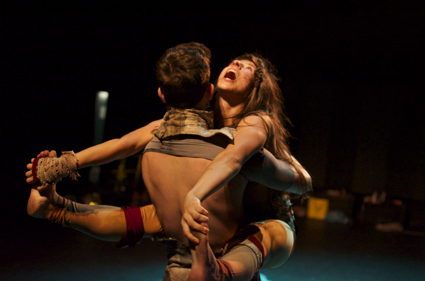Apocalyptic anxieties
Rebecca Youdell: Phluxus2 Dance Collective, de-generator

Alexander Baden-Bryce, Lucy Ingham, Phluxus2 Dance Collective
courtesy the artists
Alexander Baden-Bryce, Lucy Ingham, Phluxus2 Dance Collective
With recent global weather events and CO2 in the climate over the 400 parts per million threshold, it’s easy to understand why the paradise-lost motif has inspired choreographer Nerida Matthaei’s de-generator. As she states, it’s a response to the global obsession with the end of the world, and her firm belief that it is the destructive nature of humanity that holds the highest probability of ending our existence.
A dimly lit theatre, chairs retracted. In one half of the space, three large-scale tree-like installations comprising strong lines of black duct tape; in the other a series of illuminated collections, small heaps of outmoded technologies, plastic water bottles, torches, gas masks and such, some mounted and slung on rustic bamboo racks; the space divided by an obtrusive, jagged diagonal line, like a great primordial crack in the earth.
The de-generator narrative finds a man and woman (Alexander Baden Bryce and Lucy Ingham) discordant, infested and alone in their existence. Two solos, one after the other, enlist a language of angular, shaking, primal movement in an intersection with refined balletic control. Groping the darkness, themselves and the audience, who are free-standing in the space, the duo come to terms with their ominous world. An unfamiliar meeting of intricate and dynamic composition sees the male outsmarted and lying on the floor. Bathing him from feet to head, the woman revives the man, and the pair lyrically reconcile. Together they travel through the landscape, where she reveals her collections to him. The journey ends in a particularly lovely moment where, cradled, her hair extends like an extra limb. The work’s last moments are danced in unison, followed by a barrage of topical media sound bites describing catastrophic natural disasters and nuclear war as the silhouetted couple stand hand-in-hand in prophetic revelation.
I sense that de-generator’s intention is to startle. The inevitable examination of mortality is an attempt to portray the gravity of our current situation, and the work’s foregone tone of desolation embellishes this subtext, reinforcing it through the choreographic form. Giddying twists, spirals and extensions, sweaty limbs entwining and snapshot partnered lifts revealed a flexibility in which the intent, if physically possible, would have been to turn the body inside out.
Bleak, stark, abrasive lighting, high-key sound and post-punk-feral aesthetic couture augment the imagined catastrophe and nihilism. Was it misanthropic or merely reflecting on the helplessness of humans in a circumstance that eclipses them? Rendering it as a non-proscenium work meant that it lent itself to either interpretation, as the audience, like marsupials caught in high-beam headlights, were sent scurrying from the dancers. Some stood their ground, but as the work progressed and the dancers became space eaters, a psychology of survival seemed evident, the dancers taking over the centre space and observers gravitating to the sides of the room.
De-generator seeks out our innermost fears in an attempt to observe anxiety over events in which we have little control. Despite this, in the act of sharing her anxiety and having the dancers complete the work hand-in-hand, Nerida Matthaei aims perhaps to bring us all together.
Phluxus2 Dance Collective: de-generator, choreographer Nerida Matthaei, dancers, set and costumes Lisa Fa’alafi, sound Andrew Mills, lighting Keith Clark; Cairns Centre of Contemporary Arts, 22-25 May
RealTime issue #116 Aug-Sept 2013 pg. 46






